Formula 1 Sharks
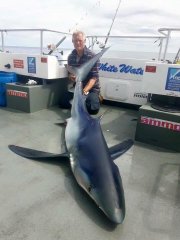
In the space of one incredible fortnight during July 2016, three potential British and two Welsh shark records were broken. I say potential because while there is absolutely no doubt about the authenticity off the three fish concerned, no records were claimed, and nor could they be, having been released after taking measurements for weight estimation in the case of the two boat caught fish. The biggest, a 368 pound Thresher Shark caught by Nick Lane, plus a 242 pound Blue Shark taken by Danny Fitch, were both disqualified through release by angler choice, and well done to both anglers and their respective charter boat skippers Daniel Hawkins and Andrew Alsop for doing that.
The third shark, a shore caught Porbeagle which would have been a record at any weight above the ridiculous British Record Fish Committee (BRFC) qualifying weight of 40 pounds which this fish clearly well bettered, was legally prevented from being brought to the scales even had captors Mark Turner and Simon Shaw wanted to, which again they didn't, all of which speaks volumes about some of the antiquated head burying dinosaurial thinking by some, though I stress not all of the people sitting on the BRFC today.
To put the legal situation regarding sharks and rays accurately into record claiming context, I had a quick word with Luce Bay charter skipper Ian Burrett, a key player within the Scottish Sea Anglers Conservation Network (SSACN) who have been taking the fight successfully to Scottish and European fisheries ministers on anglings behalf for many years. Ian confirms that Porbeagle Sharks have a zero total allowable catch (TAC) making it illegal to kill the species Europe-wide, which poses the question of how are anglers supposed to weigh them on firm ground for record claims. Is the BRFC actually encouraging people to flout the law.
Unfortunately, Tope protection sits on rather shakier foundations. Commercial boats are permitted to land up to 45 Kg in England and Wales, though there is no 'trans-shipment' allowed for recreational sea anglers. So again it would be illegal to bring a potential record ashore to comply with BRFC claim rules. As for Blue Sharks and Threshers, these could legally be landed, weighed, and claimed, but shame on any angler who would do that, and even more shame on any organisation suggesting that they must. All of which puts some current shark records into suspended animation with no future claims likely, even by record-plus fish. As I understand it, so called Common Skate (see footnote) and Undulate Rays fall in to the same category.
What then are alternatives. First amongst these is to do what most serious anglers have been doing for years and ignore the records system altogether. Many anglers see PB's or other catch and release achievements as creditable enough is a world of ever shrinking marine resources, and nobody could blame them for that. As a result, national records loose their credibility as they are over-shadowed by more worthy un-claimed contenders. But there is potentially more at stake than that. Credible scientifically useful data is also being lost, though social media reporting, if scientists know where and when to look, might help fill that particular vacuum.
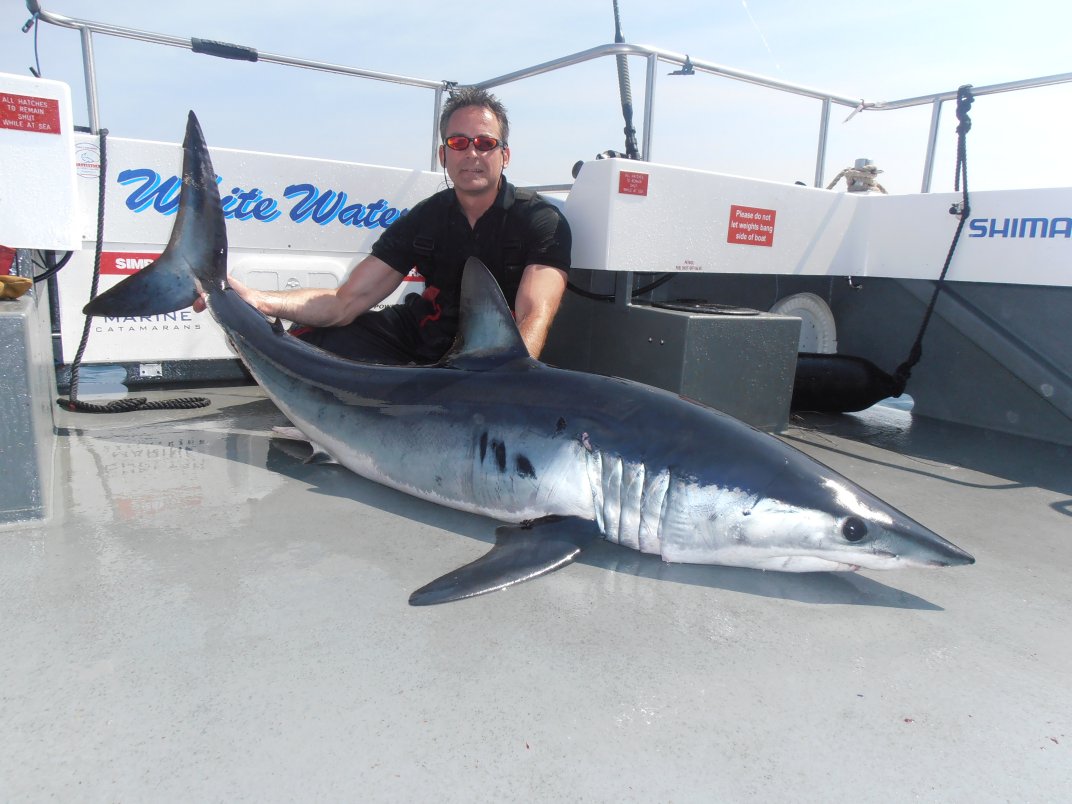
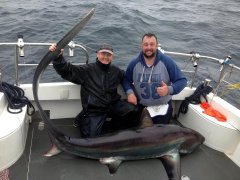
For many years, skate anglers have used weight estimation charts, either carried routinely as most do when fishing for them in the Oban area, or downloaded as required from the Scottish Skate Tagging Programme www.catchalot.co.uk/tagging/tskate.htm. Never completely accurate, and indeed not claimed to be so, they do however come within a few percentage points of the target, which as any statistician will tell you is as good as gets, on top of which they are the same for everyone, so in that sense they are as good as actual weights with the added bonus that the fish swims away at the point of capture unharmed, as per the requirements of the law.
Sharks on the other hand, which is a loose term covering everything from Dogfish to Great Whites, are different matter when it comes to weight estimation. On the one hand because these are so many different layout configurations, while on the other, estimation charts seem to be less readily available. The Welsh shore caught Porbeagle was released in the water and was therefore a rack of eye estimate which was way in excess of the BRFC minimum qualifying weight of 40 pounds. Nick Lane's Thresher on the other hand was estimated on the basis of accurate measurements handed to the Shark Trust, whilst Milford Haven charter skipper Andrew Alsop has being doing measurement based estimation for many years.
One potential down-side to shark weight estimation is not so much the inherent in-accuracies which ALL estimation formulae generate, but the sheer number of formulae available, which means that unlike with the Common Skate, you may not always be comparing like with like. So one formula needs to be agreed upon for use by everyone, and in that regard, I would propose that be the one used by the highly respected Shark Trust which is a prestigious conservation group with no vested interest in angling other that a willingness to help and to record data for scientific research.
Alternatively, and equally creditable is the SSACN website SSACN which publishes length to weight charts for the UK's smaller shark species such as Tope, Spurdogs, Huss and Smoothhound. For larger shark species, multiplying the length by the girth squared divided by 800 is said to be as good as it gets. There are others dotted around the Internet. But as I've said, we need all need to be agreed on just one. A Formula 1 approach to a Formula 1 group of fish.
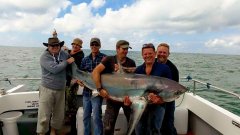
For me, a far simpler approach which I've raised both in print and directly to the BRFC is to run two record lists in tandem by incorporating an extra column next to the actual weight for fish of estimated proportions for those anglers who either don't want to, or for legal reasons are unable to put fish on a land based set of scales. Note the words 'estimated proportions'. A very carefully chosen phrase which makes no reference to weight, either estimated or actual.
Weight is one way of quoting the size of a fish. A time honoured approach which we have all become conditioned into seeing as the be all and end all of PB and record recording. But it isn't the only way. Forced by very effective legislation aimed at maintaining a healthy multi million dollar generating sport fishery, American anglers have been using length as the only means of quoting fish size for many years. For them this can easy be done while a fish left in the water, which for many US species is now a legal requirement to ensure no harm whatsoever befalls certain species.
Here in the UK we do not have that requirement....Yet. Even protected species can be carefully brought into a boat for disgorging, measuring, and photographing, where-after they must be released un-harmed at the point of capture, all of which makes perfect sense. Length taken from the tip of the snout to the fork of the tail, or end of the tail for skates and rays, is standard procedure. Skate are also measured across the wing tips with both dimensions being required for the weight estimation chart. With sharks it's a little different, plus depending on the approach you opt for, a whole lot more complicated, all of which brings me to a suggested simplification which could be used across the board to fill the all of the vacant column I suggested earlier for the BRFC and other lists.
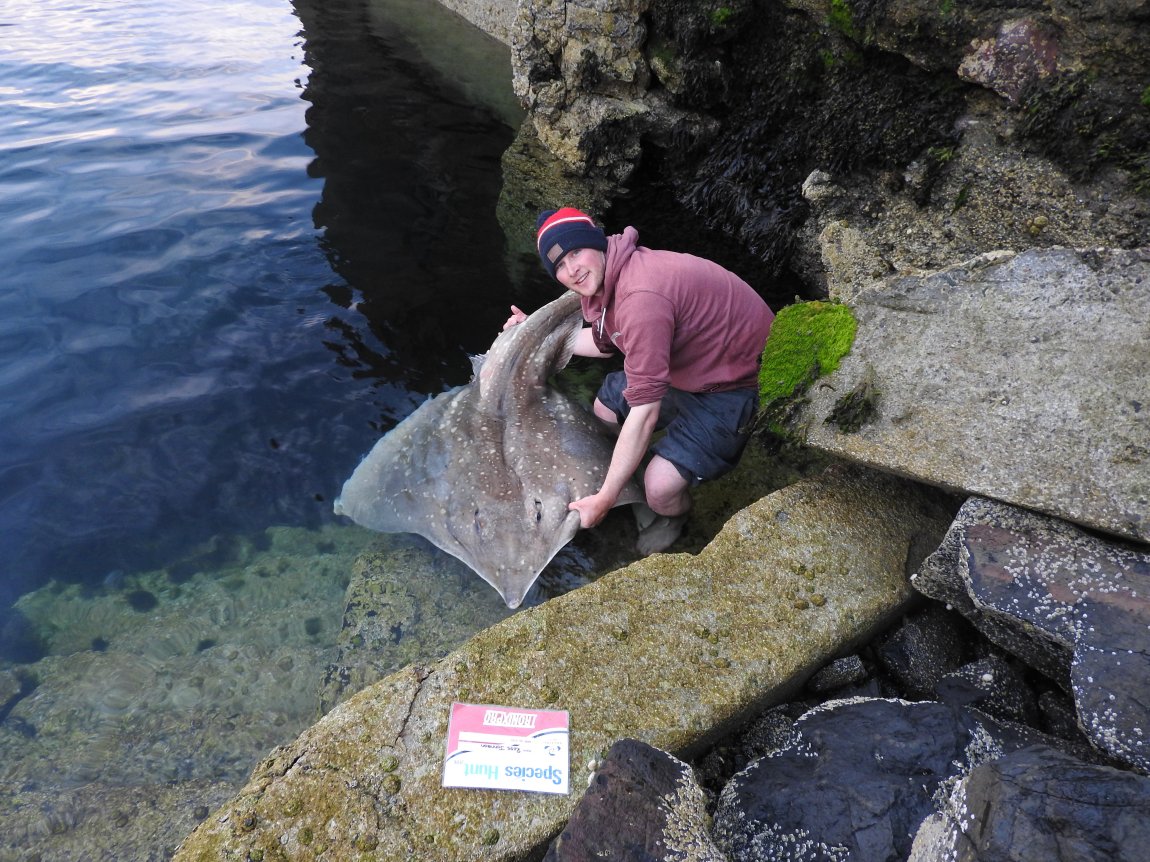
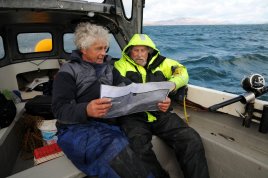
After measuring the length, put the tape measure around the girth of the fish at its widest point, then multiply the two numbers together using the calculator which most mobile phone these days carry as standard. That's it. The resulting number or points score this generates reflects the size of your catch. Fatter or longer fish which would have scored higher on a tradition weighing scale also score pro-rata higher here. Points and actual weights mirror each other. It's just a matter then of getting used to seeing points instead of the pounds and ounces or kilo's we have become conditioned to scoring fish size with.
After measuring the length, put the tape measure around the girth of the fish at its widest point, then multiply the two numbers together using the calculator which most mobile phone these days carry as standard. That's it. The resulting number or points score this generates reflects the size of your catch. Fatter or longer fish which would have scored higher on a tradition weighing scale also score pro-rata higher here. Points and actual weights mirror each other. It's just a matter then of getting used to seeing points instead of the pounds and ounces or kilo's we have become conditioned to scoring fish size with.
FOOTNOTE: The Common Skate Raja batis is no more, which is no bad thing, as it was hardly the most appropriate name for a fish of such localised distribution and in need of legislative help due to over-fishing.
It all started with the Common Skate as a species being taken out of the genus Raja and placed into the genus Dipturus. Then shortly afterwards, it was discovered that what had been thought of as one species with the new scientific name of Dipturus batis was in fact two very similar species. So that name too had to be binned in favour of two new ones - the Flapper Skate Dipturus intermedia, and the Blue Skate Dipturus flossada, the unfortunate knock on consequence of which being that we've now gone from what was one of the easiest and most straight forward fish naming exercises to one of the hardest, as Flapper Skate and Blue Skate are so much alike, hence the earlier confusion.

The five main points of difference are........
- 1. Eye colour: Both the easiest to determine and arguably the key identifier. In the Flapper Skate it is dark green or olive, whereas in the Blue Skate it is a pale yellow.
- 2. Blotches on the wings: Flapper Skate have dark blotches covered in lighter yellowish spots, whereas Blue Skate have dark blotches ringed by yellowish brown.
- 3. Tail Spines: To say that these are larger and more prominent in Flapper Skate is of little help unless a direct comparison can be made, which is one field observation anglers will not be in a position to make.
- 4. Dorsal fins: As in all skates and rays, these are set well back towards the end of the tail. In the case of Blue Skate, the gap between them is very small, whereas in Flapper Skate it's approximately half a fin width wide.
- 5. Teeth: Again, not something for anglers to undertake as a field observation, if for no other reason than their own safety, plus of course the well being of the fish.( 4)
The obvious question has to be, which of the two species occupies the current 'Common Skate' record slot, and how do we know. In all probability it will be the Flapper Skate. For while the two species do overlap geographically, fish caught in what are (or now were) traditional Common Skate haunts along the west coast of Scotland are thought to be Flapper Skate D. intermedia, which as it turns out is the bigger of the two species. Blue Skate D. flossada are said to have a marked southerly bias and are more likely to be the ones found in the Irish Sea and Celtic Sea, making the likelihood of fish caught off the southern and western Irish coast being Blue Skate.